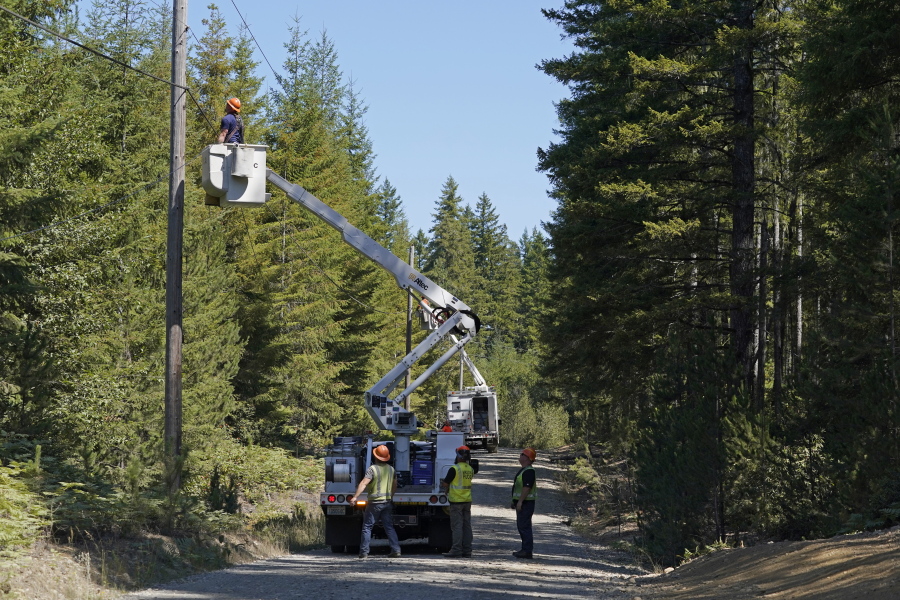Washington state will get more than $1.2 billion from the federal government to deliver high-speed internet to communities with slow, unreliable or nonexistent service, the Biden administration announced Monday.
Aimed at closing the digital divide that disproportionately impacts rural areas and low-income communities, more than $42 billion will be distributed to states as part of the Broadband Equity, Access and Deployment program, funded by the 2021 bipartisan infrastructure law.
Estimates on the number of people who struggle with slow or no internet in Washington vary, ranging from 239,000 residents to more than 2 million. In Washington and across the country, residents living in rural communities and tribal lands in particular struggle to access affordable, broadband internet.
White House officials touted the effort as the largest-ever funding announcement to increase access to reliable high-speed internet, likening the investment to President Franklin D. Roosevelt’s Rural Electrification Act in 1936, which brought electricity to farms, ranches and other remote areas of America.
During his announcement Monday, President Joe Biden pledged every household in the country would have access to affordable high-speed internet by 2030.
“For today’s economy to work for everyone, internet access is just as important as electricity was or water or other basic services,” Biden said. “High-speed internet isn’t a luxury anymore, it’s become an absolute necessity.”
More than 8.5 million U.S. homes and businesses lack access to high-speed broadband, according to the Federal Communications Commission, though some experts say the number of people without reliable and fast internet is likely higher.
In rural areas, difficult terrain makes it expensive to lay fiber-optic cables that would improve internet quality, and smaller populations yield less of a return on investment for service providers. Service there often relies on traditional copper lines or satellite technology, which can be laggy. People of color, low-income residents and older adults are more likely to lack broadband access.
Establishing high-speed internet access can cost as much $10,000 per address, said Mark Vasconi, director of the Washington State Broadband Office. All told, connecting unserved households and businesses in Washington state could cost more than $2.4 billion at minimum, he said, double what the state received Monday.
“Connecting broadband requires an astonishing amount of money,” Vasconi said, adding that state and private investments may make up the shortfall. “It’s very different than building a road. The level of maintenance and operating cost for broad connection and service is substantially higher than other pieces of infrastructure.”
Few aspects of daily life in modern society are untouched by the internet. Access to it and fast download speeds can determine how easily you’re able to use telehealth appointments, sign on to Zoom classes and meetings, stream movies and TV and generally browse online. A bevy of studies have found limited internet access can impact educational outcomes, health care options, economic growth and employment opportunities.
As the world went even more online during the COVID-19 pandemic, people with slow, spotty or no internet found themselves even more isolated, severed from school, health care, job opportunities, media entertainment, social media, online food delivery and more.
“Everyone deserves internet access, and this funding will make sure no one is left behind in our effort,” said U.S. Rep. Pramila Jayapal, D-Wash., in a tweet Monday.
The investment is on top of another $23 billion included in the 2021 infrastructure law to fund five specific programs, including improving high-speed internet on tribal lands and helping low-income households save on their internet bill.
In addition, the American Rescue Plan included more than $25 billion toward programs to close the digital divide and get more people connected to high-speed internet.
The FCC considers internet service as “broadband” if it delivers download speeds of at least 25 megabits per second (Mbps) and upload speeds of at least 3 Mbps, which some have criticized as an antiquated standard. The agency considers households or businesses without access to download speeds of 100 Mbps as underserved.
Washington state’s ultimate goal is to provide download and upload speeds of 150 Mbps to all residents and businesses by 2028.
Getting an accurate sense of just how many people struggle with unreliable or nonexistent internet access is difficult, with varying estimates from federal agencies, private companies and nonprofit groups.
The U.S. Census Bureau from 2021 indicates about 10% of state households don’t have a broadband internet subscription, translating to about 264,000 households, according to the Washington State Broadband Office. Data collected by Microsoft estimates nearly 30% don’t have broadband internet.
The state’s Broadband Office also collects internet speed test data as part of a federal survey and mapping project. Of the roughly 48,000 people who have submitted test results so far, about 45% had no service or a download speed of less than 10 Mbps, less than half of the FCC’s minimum standard.
In the counties of Ferry, Skamania, Okanogan, Adams, Stevens, Pend Oreille, Columbia and Klickitat, at least 4 in 5 survey respondents reported no internet access or broadband service.
States have until the end of the year to submit proposals detailing how they plan to use money from the Broadband Equity, Access and Deployment program. After the Commerce Department approves initial plans, states will then award grants to telecommunications companies, public utilities, electric cooperatives, municipal governments and other service providers to expand internet infrastructure.



